Ron StageMaster 6000 G4 Wireless & Wired Shackle Pin Load Cell
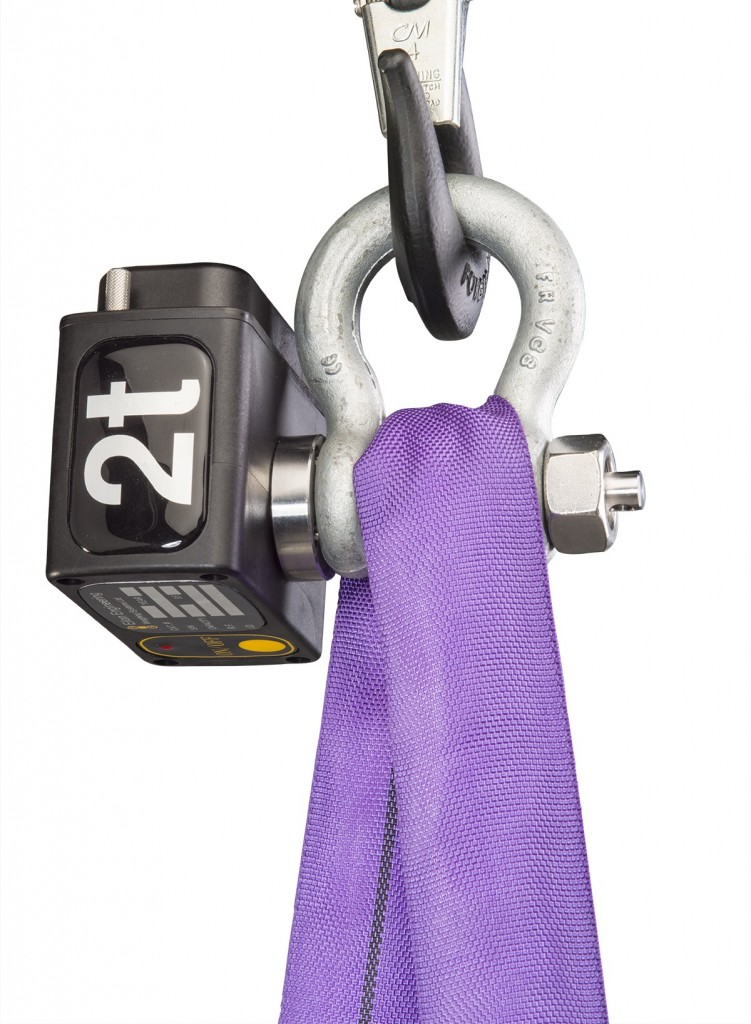
Eilon Engineering Offers New Ron StageMaster 6000 G4 Wireless and Wired Shackle Pin Load Cell
Talk about a mouth load! With heavy loads above our heads and safety on every ones mind, monitoring the weight of truss has be come an inportant topic in the industry. Eilon Engineering offers a new load cell monitoring system that is built right into the shackle for ease of use. If you are one of those that don’t truss wireless signals for an important task such as load monitoring, have no fear, the new Ron Stagemaster 6000 is offered in both wireless and wired.
Here is more from Eilon Engineering:
Eilon Engineering announces launch of the new Ron StageMaster (RSM) 6000 G4 Wireless and Wired Shackle Pin load cell for load monitoring and overload prevention. The advanced load cell features a new shackle pin design that makes it ideal for applications where headroom is extremely limited while its wireless capability makes for a quicker installation.
The RSM 6000 G4 Shackle Pin load cell includes a 5/8″ standard shackle enabling an extremely low headroom loss of only 2.4 inches (61mm), especially important in indoor applications where ceiling height is often an issue. Made of aerospace quality, high-strength alloy steel, the RSM 6000 G4 Shackle Pin load cell, like all Eilon Engineering load cells, is fatigue rated to withstand unlimited load cycles without the risk of failure or damage to the steel. The RSM system features continuous monitoring up to 5000 hours (10,000 hour battery life option), and unlike other systems on the market contains absolutely no standby or sleep modes, which are risky and unacceptable from a safety perspective.
Safety above all
In addition to the fatigue-rated load cells and continuous monitoring up to 5000 hours, the RSM system includes a raft of other safety features including independent data flow and multi-channel transmission, as well as internal verification, an internal safety check that ensures the displayed data is always an exact match with that being transmitted by the load cells. An extended transmission range up to 2km adds an additional layer of safety. Furthermore, Ron StageMaster load cells work with any motor control system to provide automatic emergency stop (E-stop) and overload/under-load alarm (visual and audible).
Ease of operation and setup
The IP 65-rated system communicates wirelessly to a PC laptop via a receiver, eliminating messy cabling and lengthy setup time. The result is a quick-to-install plug and play system, essential in many facets of the entertainment industry like tours and on-the-road productions. And thanks to a Slave-Master option, a nearly unlimited number of load cells can be used.
Real-time monitoring
The laptop-based Ron StageMaster safety system features real-time monitoring of all loads from a single screen and from any location. And for simple integration with the plot, the RSM system software allows for overlay of the load map right onto the plot on screen, making it easy to see where motors, weight, etc. are on the plot. This enables the rigger to immediately identify the location of an overload and take swift preventative action. In addition, the set point option enables immediate motor stop in case of an overload. The system provides a record at the end of the show, is compatible with smart phones and tablets and can even send SMS alerts.
RSM compatibility
The RSM 6000 G4 Wireless and Wired Shackle Pin load cell is compatible with all Eilon RSM G4 systems (wired and wireless), including the Ron StageMaster Classic and the recently launched Ron StageMaster Hoist Integrated load cell.
For more details visit www.eilon-engineering.com
City Theatrical Launches sHoW DMX Neo & Baby
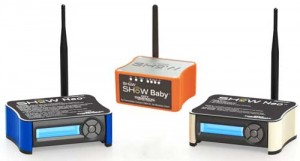 City Theatrical is proud to announce their newest generation of wireless DMX: SHoW DMX Neo. SHoW DMX Neo features the world’s highest fidelity, combined with blazing fast 7mS (or less) latency. Users can choose from three operating modes, including Neo, Neo Adaptive, and Classic mode that is compatible with all existing SHoW DMX products.
City Theatrical is proud to announce their newest generation of wireless DMX: SHoW DMX Neo. SHoW DMX Neo features the world’s highest fidelity, combined with blazing fast 7mS (or less) latency. Users can choose from three operating modes, including Neo, Neo Adaptive, and Classic mode that is compatible with all existing SHoW DMX products.
Learn more about sHoW DMX Neo by downloading the data sheet.
If SHoW DMX Neo is about user control, SHoW DMX SHoW Baby is about simplicity. Although SHoW Baby is fast and powerful, it has no user controls at all! Each SHoW Baby is a Transceiver. You don’t need to purchase separate Transmitters and Receivers. To turn a Transceiver into a Transmitter, simply plug DMX in. To make it a Receiver, don’t plug DMX in. That’s all there is to it! All units are completely plug and play and you can set up your system in seconds.
But while SHoW Baby is simple to set up, it contains the same fast and powerful radio as SHoW DMX Neo, and since it is in the Neo family, you can mix and match SHoW Baby and Neo together in your system.
Learn more about the sHoW DMX Baby by downloading the data sheet.
Review: The TRX Series, from City Theatrical and Philips Color Kinetics
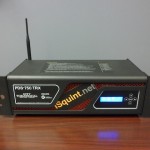 Not long ago, Philips Color Kinetics introduced the next generation of Color Blast’s: The TRX Series. Adding 2 new colors to the standard regimen of Red, Green, and Blue, these new Color Blasts called for a more intelligent power supply. Providing this new backbone is City Theatrical and the new PDS-750 TRX Power and Data Supply. Not one to rest on their laurels, City Theatrical raised the bar with this reinvention of their industry standard PDS. Lets start at the beginning:
Not long ago, Philips Color Kinetics introduced the next generation of Color Blast’s: The TRX Series. Adding 2 new colors to the standard regimen of Red, Green, and Blue, these new Color Blasts called for a more intelligent power supply. Providing this new backbone is City Theatrical and the new PDS-750 TRX Power and Data Supply. Not one to rest on their laurels, City Theatrical raised the bar with this reinvention of their industry standard PDS. Lets start at the beginning:
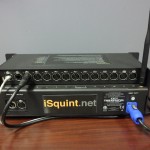 The PDS 750 TRX is housed in a very sturdy, 3U rack mount or pipe mount housing. The front panel has the factory label; a stylish, red air flow grill; and the back-lit LED display and 5 button control interface. On the top of the fixture is a welcome cheat sheet that covers basic setup in all modes. The back panel contains the PowerCon power input and fuse, the 5-Pin DMX In and Out, a USB connection for software updates, a 2-port EtherCon switch, the 12 4-Pin Fixture outputs, and the SHoW DMX wireless antenna. There is also a small hole in the metal casing, presumably for a safety cable if you are pipe mounting the PDS.
The PDS 750 TRX is housed in a very sturdy, 3U rack mount or pipe mount housing. The front panel has the factory label; a stylish, red air flow grill; and the back-lit LED display and 5 button control interface. On the top of the fixture is a welcome cheat sheet that covers basic setup in all modes. The back panel contains the PowerCon power input and fuse, the 5-Pin DMX In and Out, a USB connection for software updates, a 2-port EtherCon switch, the 12 4-Pin Fixture outputs, and the SHoW DMX wireless antenna. There is also a small hole in the metal casing, presumably for a safety cable if you are pipe mounting the PDS.
Control of PDS-750 TRX is available via wired DMX, wireless SHoW DMX, Ethernet (ArtNet, sACN, or Ki-Net) or using one of the on-board programs or static colors. Setup is quick and simple. Plug in your power cord and hook up your fixtures and then using either the on-board setup wizard or the advanced setup menus you can select your method of control. The PDS-750 TRX will run any combination of 2, 3 or 5 color CK fixtures. Using the on-board fixture patch you can actively adapt the fixture’s address’s so that there are no wasted DMX channels as in the past. A nice part about the setup wizard is that it will also identify the types of fixtures connected and ask you what control profile you want to use.
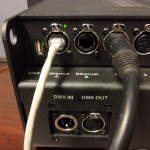 DMX control of the PDS-750 TRX is as simple as connecting a control source to the 5-pin input on the unit. In basic 8-bit mode, the fixtures operate on one channel per color, up to the full 5 colors available in the Color Blast TRX’s. Using my test console (an Elation SDC-6), the Color Blast dimmed smoothly and with a very even curve.
DMX control of the PDS-750 TRX is as simple as connecting a control source to the 5-pin input on the unit. In basic 8-bit mode, the fixtures operate on one channel per color, up to the full 5 colors available in the Color Blast TRX’s. Using my test console (an Elation SDC-6), the Color Blast dimmed smoothly and with a very even curve.
SHoW DMX control allows the PDS to operate wirelessly on any one of 16 different channels (or universes). Using the same test console connected to a standard SHoW DMX indoor transmitter, I had full control of the fixture with zero lag time despite four WiFi networks and Bluetooth scanners also running in the same environment. A feature of note when running SHoW DMX is that the DMX connector on the back of the PDS will output whatever universe the PDS is receiving. This allows you to control the rest of your DMX devices without investing in more receivers. It’s a very nice hat-tip from the folks at CTI.
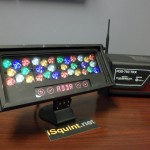 Ethernet control of the PDS was a bit more challenging, but only due to the steps needed to enter the IP address information. You can control the PDS over ArtNet, sACN (think ETCNet 3), or Ki-Net (Color Kinetics Architectural). Having the extra Ethernet port is an excellent add-on that makes daisy chaining multiple PDS units a snap.
Ethernet control of the PDS was a bit more challenging, but only due to the steps needed to enter the IP address information. You can control the PDS over ArtNet, sACN (think ETCNet 3), or Ki-Net (Color Kinetics Architectural). Having the extra Ethernet port is an excellent add-on that makes daisy chaining multiple PDS units a snap.
Not having a sACN source, I setup and configured the PDS for ArtNet control on a static IP address. I then logged into the WiFi network with my iPad and using Alcorn McBride’s LightingPad was able to control the PDS perfectly. There was no lag time and the dimming curves were as smooth as ever. CTI also gives Ethernet control the same hat-tip as SHoW DMX by outputting the same control universe to the DMX port on back.
Not to be outdone, Philips Color Kinetics has taken the next generation Color Blast TRX to the next level. Featuring not just RGB color mixing, CK added Amber and White to the mix. For theatre and Broadway applications, the soft tones that can now be mixed are a most welcome addition. The Color Blast TRX also features a first-ever 4-character LED display and touch sensitive buttons for at-fixture controls. As introduced with the TR, the TRX features both clear and frosted lenses that can be swapped out. The rubber surround is gone and in its place is a CTI accessory holder.
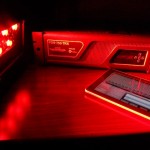 Operation of the on-board control is simple and elegant. Press the two outermost buttons at the same time and the controls unlock for about 60 seconds. You can set the DMX address, fixture profile, set static colors, chases, and run a test mode to name a few functions. The control buttons use the same type of touch sensor glass that many smart phones use. You don’t actually press them, you just tap them. One would imagine this will significantly increase fixture reliability as adding physical contactors adds a mechanical failure point.
Operation of the on-board control is simple and elegant. Press the two outermost buttons at the same time and the controls unlock for about 60 seconds. You can set the DMX address, fixture profile, set static colors, chases, and run a test mode to name a few functions. The control buttons use the same type of touch sensor glass that many smart phones use. You don’t actually press them, you just tap them. One would imagine this will significantly increase fixture reliability as adding physical contactors adds a mechanical failure point.
Overall the color mix and output of the new Color Blast TRX is excellent. However, don’t get rid of your iW Blasts just yet. The amber and white are excellent additions that allow the TRX to mix some amazing new colors. However, the white and amber only output is just not quite bright enough to be effective on its own. Overall though, Philips Color Kinetics has added an excellent new addition to the Color Blast legacy. Combined with City Theatrical’s new PDS-750 TRX, the bar has been set for ease of use and functionality.
 The new TRX technology is available now for purchase and rental from most of your top lighting dealers in the US. To round out the family, CTI also introduced the new PDS-350 TRX (6-channel vs. 12-channel). For more information please visit either City Theatrical or Color Kinetic’s websites.
The new TRX technology is available now for purchase and rental from most of your top lighting dealers in the US. To round out the family, CTI also introduced the new PDS-350 TRX (6-channel vs. 12-channel). For more information please visit either City Theatrical or Color Kinetic’s websites.
LumenRadio Available in North America AGAIN Through TMB

TMB and LumenRadio announced today the immediate availability across North America of the entire range of CRMX wireless lighting control products.
LumenRadio’s proprietary CRMX products are available in a variety of form factors and feature levels to meet the requirements of the entertainment and architectural lighting markets alike. All products provide Lumen’s proprietary automated cognitive coexistence; error correction; synchronization; encryption; deterministic latency of 5ms; and outstanding range and reliability. Protocol support includes DMX, RDM, DALI, Art-Net, sACN, ETCNet2, ETC Net3, Strand ShowNet, and Pathport. Two consecutive PLASA Awards for Innovation and accolades from industry experts and the industry at large, as well as a very impressive reference list of high profile installations and events, have firmly established LumenRadio as the undisputed wireless technology leader.
See the full range of LumenRadio products at USITT 2011. TMB is exclusive distributor for LumenRadio in North America and the UK. For more information about LumenRadio and CRMX wireless lighting controls please visit www.tmb.com/lumenradio or www.lumenradio.com.
Baxter Controls Pocket iPhone DMX App
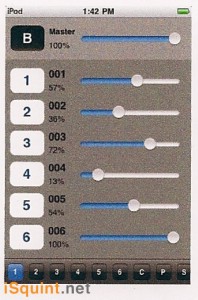 During LDI 2009, I got a chance to stop by the BCI or Baxter Controls booth to take a look at his latest product, the iPhone Virtual Pocket Console app. The iPhone app is still under development and is not ready for release as of yet. BCI did have a beta version of the App on their iPod Touch running the booth and the Par-B-Q cooker.
During LDI 2009, I got a chance to stop by the BCI or Baxter Controls booth to take a look at his latest product, the iPhone Virtual Pocket Console app. The iPhone app is still under development and is not ready for release as of yet. BCI did have a beta version of the App on their iPod Touch running the booth and the Par-B-Q cooker.
The Virtual Pocket Console App utilizes wireless network protocol to control DMX. The iPhone/iPod Touch connect to the BCI Pocket Console Net/DMX converter box to translate the signal to 5-pin DMX. I am still a little unsure if BCI is using Art-Net or not, but time will tell.
The Virtual Pocket Console can Patch up an entire universe of DMX512 and give you the ability to check dimmers, channel levels, and record simple looks.
A time frame or pricing has not been released yet. I am expecting to see something more about the iPhone app in the first quarter of 2010.
What to see more about the neat products from BCI, visit their website at www.dmx2go.com.
[nggallery id=16]
Clear-Com’s Two-Channel Tempest Wireless Intercom
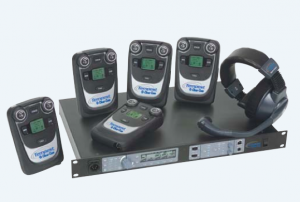 Clear-Com, one of the leaders in intercom systems announced a new addition to their Tempest 2400 2.4Ghz wireless Intercom Family, the Tempest two-channel wireless intercom system. While at LDI, I did not have a chance to stop by the Clear-Com booth and take a closer look at this, but here is more information from the press release Clear-Com sent out after the show.
Clear-Com, one of the leaders in intercom systems announced a new addition to their Tempest 2400 2.4Ghz wireless Intercom Family, the Tempest two-channel wireless intercom system. While at LDI, I did not have a chance to stop by the Clear-Com booth and take a closer look at this, but here is more information from the press release Clear-Com sent out after the show.
As with all members of the Tempest family, the two-channel Tempest2400 utilizes a patented Frequency Hopping Spread Spectrum RF scheme that not only avoids the need for licensing and frequency coordination, but makes it fundamentally resistant to interference from other wireless devices. This ensures that no matter how crowded the RF environment, communications will go off without a hitch. In addition, once registered to a base station, a beltstation needs no further configuration and roams freely within a single coverage area.
Each Tempest2400 base station supports up to five full-duplex, two audio-channel digital wireless beltstations; by stacking up to 10 base stations together, 50 independent, full-duplex wireless beltstations can operate together in a single system. Other major features include state-of-the-art 2xTX Transmission Voice Data Redundancy and its interoperability with Clear-Com and other intercom systems through two-wire and four-wire connections.
Additionally, the iSelect™ roaming feature allows a beltstation user to move from one coverage area to the next by simply changing the beltstation’s association to another base station; each beltstation can be paired with up to 64 different base stations. Each Tempest2400 wireless system includes T-Desk software, a powerful PC-based control and configuration application. T-Desk offers the ability to monitor and manage the entire wireless system from a remote location via Ethernet connection to a LAN. A PC running T-Desk can also interface with a base station via direct connection over CAT-5 cable.
All members of the Tempest2400 family include an optional remote transceiver that allows remote antenna placement up to 1,500 feet (450 meters) from the base station; data connection and power supplied over standard CAT5e/6 cable with lightweight, fast-charging Lithium Polymer (Li-Poly) battery technology in the beltstation; access to one of six relay closures from the beltstation and vibrating call alert. In addition, a flexible battery solution allows beltstations to operate on standard AA batteries for emergency use; beltstation battery telemetry is displayed in real-time on the beltstation and base station LCDs, indicating how much power is left in each pack.
for more information on the Tempest two-channel intercom system, visit Clear-Com’s website at www.clearcom.com.
Lumens in the Air with LumenRadio
 One of the newer products that I got a chance to play with at LDI this year that wasn’t an LED fixture was the LumenRadio system. LumenRadio made it’s debut into the entertainment lighting industry at the PLASA show this year and took home PLASA’s 2009 Award for Innovation.
One of the newer products that I got a chance to play with at LDI this year that wasn’t an LED fixture was the LumenRadio system. LumenRadio made it’s debut into the entertainment lighting industry at the PLASA show this year and took home PLASA’s 2009 Award for Innovation.
LumenRadio is a wireless system to send DMX information over a wireless network. What is unique about Lumen Radio is that it is the first smart wireless system to automatically adapt to its surroundings. Meaning, that the Lumen Radio system looks for open or un used space on a wireless bandwidth and takes advantage of that un used space to transmit and receive DMX singal.
LumenRadio launched uses a wireless technology called CRMX which stands for Cognitive Radio Multiplexer. CRMX was specifically developed to meet the demand for reliable, easy to use, and cost effective wireless lighting controls.
So what does Cognitive Coexistence mean for us?
Wireless DMX distribution systems operate on the same license free frequencies as W-LAN (WiFi), ZigBee, Bluetooth, some wireless intercoms, etc. Interference between such systems has been a growing problem in the industry with no available solution. CRMX is the first system to continuously scan the radio spectrum and dynamically adapt its frequency hopping patterns. This eliminates interference and maximizes performance of all radio systems in the same radio frequency sphere. In short, it’s a smart radio that adapts without having the user doing anything at all.
CRMX Nova features a number of unique features, such as:
- Automated Cognitive Coexistence. The unique CRMX technology makes sure that your wireless transmissions never disturb, or are disturbed by, other wireless equipment. This fully automated feature offers unrivaled convenience and peace of mind during operation.
- Fidelity. The DMX frame output is identical to the frame input. DMX frames will not be only half updated.
- Error correction. Advanced algorithms recreate corrupt or lost radio packets.
- Compliance. Non-compliant DMX signals are corrected to meet the DMX512-A standard.
- DMX synchronization. Precision timing mechanism guarantees synchronized frame delivery. The DMX frame will be outputted at all of the receivers synchronized. This ensures that no time differences occurs is the signals.
- Low latency. Industry best; below 5ms even in multi-universe systems.
- High security. Strong 128 bit encryption keeps hackers out.
LumenRadio has a number of products to transmit and receive signal all in various “sizes”. You can go from a single universe of DMX on the CRMX Nova TX, to two universe with the CRMX Nova TX2 and finally the CRMX Nova TX2 RDM which transmits both DMX and RDM, (Remote Device Management).
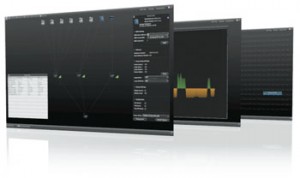 What caught my attention at the LumenRadio booth was their SuperNova software. CRMX SuperNova is an RDM Controller that comes free of charge with LumenRadio’s CRMX Nova™ RDM products. CRMX SuperNova lets you set up, monitor and troubleshoot RDM systems. Once you have connected your devices, just run a discovery process that will find all your RDM enabled devices in the network. You can map your RDM transmitters and Recivers in an view similar to how you physically have them laid out and click on each of the devices to “identify” them as well as get vital information from them.
What caught my attention at the LumenRadio booth was their SuperNova software. CRMX SuperNova is an RDM Controller that comes free of charge with LumenRadio’s CRMX Nova™ RDM products. CRMX SuperNova lets you set up, monitor and troubleshoot RDM systems. Once you have connected your devices, just run a discovery process that will find all your RDM enabled devices in the network. You can map your RDM transmitters and Recivers in an view similar to how you physically have them laid out and click on each of the devices to “identify” them as well as get vital information from them.
SuperNova also give you a graphically view of the full spectrum of wireless signal to see where open sections of the spectrum as well as limit which part of the spectrum to use or avoid. On the RDM side, you can quickly re-address a device any where on the DMX universe by simple clicking and dragging the device to it’s new address. The entire SuperNova software runs on Java and is able to work on any platform of computers.
For more infomation on the SuperNova Software or any of LumenRadio’s products, visit their website at www.lumenradio.com.
Lutron Introduces New Wireless Occupancy Sensor
 One of the interesting new products found at Lightfair this year was Lutron’s new line of wireless occupancy sensors. These new sensors will work with new single dimmer wall boxes that contain the wireless technology as well as new Grafik Eye systems. The most interesting thing about the whole system is that its totally scalable. You can have multiple sensors and/or multiple dimmers in the same system to help create a simple, self contained system. Each sensor includes batteries that are estimated to last 1o years and have user definable settings for on/off time, off only, and sensitivity.
One of the interesting new products found at Lightfair this year was Lutron’s new line of wireless occupancy sensors. These new sensors will work with new single dimmer wall boxes that contain the wireless technology as well as new Grafik Eye systems. The most interesting thing about the whole system is that its totally scalable. You can have multiple sensors and/or multiple dimmers in the same system to help create a simple, self contained system. Each sensor includes batteries that are estimated to last 1o years and have user definable settings for on/off time, off only, and sensitivity.
via Zoll Design
Update: Luminair v1.5 Screen Shots
 We mentioned a week or so ago about Synthe FX is getting ready to release an update to their iPhone/iPod Touch app, Luminair, version 1.5. We have been following their twitter feed (@synthefx) over the last couple of days and noticed that they had some more “leaked” screen shots of the updated version.
We mentioned a week or so ago about Synthe FX is getting ready to release an update to their iPhone/iPod Touch app, Luminair, version 1.5. We have been following their twitter feed (@synthefx) over the last couple of days and noticed that they had some more “leaked” screen shots of the updated version.
Luminair is a featured packed lighting console in the palm of your hand. You can run a full universe of DMX through the iPhone app to control anything from conventionals to moving lights right from your iPhone or iPod Touch. It works wireless networking or Wifi on an Art-Net system to send DMX signal over network protocol and then translate it to DMX via an Art-Net ready or compatible DMX node such as those available from Enttec.
We have contacted our mole deep with in the Cincinnati base company to prob for more information on up coming features and additions to Luminair 1.5. Be sure to click through for more information and to peak at the leak screen shots.
ETC iRFR iPhone App – Update
 We wrote yesterday about ETC demonstrating one of their latest products on the show floor of the USITT Stge Expo, the iPhone iRFR app. We were able to get a few more images of the iRFR in action as well as a bit more information. One of our readers, robinsta, talked with ETC reps in the booth and was able to get a price on the new app at $ 49.95. Compared to some apps in the iTunes library, this may seem a little high, but with the features this app provides it will be well worth the money. Then of course there is the fact that either all or portion of the proceeds goes to Behind the Scenes and Light Relief, makes it even more appealing.
We wrote yesterday about ETC demonstrating one of their latest products on the show floor of the USITT Stge Expo, the iPhone iRFR app. We were able to get a few more images of the iRFR in action as well as a bit more information. One of our readers, robinsta, talked with ETC reps in the booth and was able to get a price on the new app at $ 49.95. Compared to some apps in the iTunes library, this may seem a little high, but with the features this app provides it will be well worth the money. Then of course there is the fact that either all or portion of the proceeds goes to Behind the Scenes and Light Relief, makes it even more appealing.
We are still waiting to hear when the iRFR app will be ready for download from the iTunes store. At the time of this writing, it has not been added. We also have to wait for the latest version of the Eos/Ion operating system upgrade to be released from ETC in order for the iRFR app to work in conjunction with the consoles.
We have added a couple more screen shots of the iRFR iPhone app in action to the 2009 USITT Photo Gallery.
Update: FCC Opens up “White Space” to Tech Companies
 Recently, we wrote an update on the “white space” spectrum of the wireless band in the United States and what that means for the entertainment industry. You can read our posting about the “white space” here.
Recently, we wrote an update on the “white space” spectrum of the wireless band in the United States and what that means for the entertainment industry. You can read our posting about the “white space” here.
Today we received an email for a reader in the industry about the status of the “white space”. Seems like the FCC has opened up that spectrum to tech companies such as Google and Microsoft, granting them free, unlicensed wireless devices access to chucks of the unused airwaves on the spectrum.
The Federal Communications Commission (FCC) yesterday gave Google, Microsoft and a number of other tech companies what they wanted by granting free, unlicensed wireless devices access to chunks of unused airwaves on the broadcast spectrum known as “white spaces” (so-named because they provide a buffer between broadcast channels). Critics of the move fear that a flood of wireless devices, unregulated by the FCC, will interfere with TV programming.
The FCC, which voted unanimously 5-0 to open up white space access, said the move will allow “new and innovative” types of wireless devices—next-generation cell phones and computers, for example—to take advantage of faster broadband connections, the key to better managing streaming video and other large data files.
via: email & sciam.com
Read more about the rulings and what this means on www.sciam.com. And thanks to one of our readers, TN for bringing this to our attention!
LatestHeadlines
- Upgrading Your Toolbox: City Theatrical DMXcat-E and DMXcat Multi Function Test Tool
- Claypaky Bringing Back the Sexy to Par Cans with the Midi-B FX
- Ayrton Evolves the Cobra, the Cobra2 Developed for the US Market
- MA Lighting Intros grandMA3 onPC Fader Wing and DIN-Rail Nodes
- Live Events LEVL Up Fest: A Festival to Aid our Industry